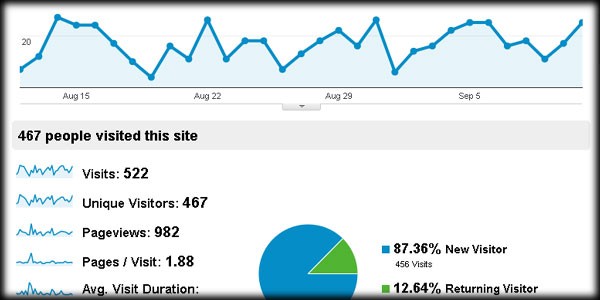By focusing on just three aspects of Google Analytics, you can start to get your head around how you might want to make changes to various areas of your website based on what you find in your reports. In this article we give you those first three things beginners should understand, and we explain why they’re important.
Although your web host probably provides some statistics gathering system, almost everyone uses Google Analytics today. It’s free, it’s a very good tracking tool, and it is provided by the very organization that most of us are trying to rank well for. It makes sense to understand this tool as well as possible.
Visits vs. Hits
We won't be discussing "hits" as it is now a pretty outdated statistic that isn't all that valuable for most webmasters these days. A "hit" is basically anything on a web page that is accessed when that page is loaded in a user's browser. If there are ten pictures, a CSS file, a JavaScript file and an HTML file, that one page will generate at least 13 hits. We aren’t really tracking how many "things" on a page are loaded, so we will focus on visits in Google Analytics.
The term "visit" represents someone coming to your site and viewing one or more pages. The term might make more sense if it was called "session" instead, and those terms are somewhat interchangeable. Since it is very possible that Google could be reporting the same visitor twice, it’s very important to be aware of the difference between visit and unique visitors.
Here's the over-simplified version of a visit in Google Analytics…
A user viewing a page on your site establishes a new visit. No matter how long they are on your site, they will continue to register only one visit unless one of the following happens:
- More than 30 minutes passes before any kind of activity occurs, such as a link click.
- They re-enter your site from another "campaign," such as a different paid keyword ad.
- Midnight passes, based on your server's time zone settings. Midnight will always establish a new visit, no matter when that user first reached your site.
There are some other nuances, but that sums up the basics of a user visit in Google Analytics. This is different from a unique visitor because clearly a user can create several visits within a given time period. Looking at unique visitors shows a better picture of how many distinct people are coming to your site in any time period. Both visits and unique visitors are very good stats to watch, but for now just make sure you understand what a visit is.
Traffic Sources
Traffic Sources is somewhat self-explanatory, but to be clear this is what you should understand about the types of sources.
- Search Traffic is a measure of the users that are finding your website through Google, Bing, Yahoo and any other search engines on the web.
- Referral Traffic is a measure of the users that are finding you through links on other websites, in emails or any other "third party" method.
- Direct Traffic is a measure of those users who have typed your domain name in directly to reach your site. This is actually a good measure of how strong your brand name might be. If many people are reaching you this way, chances are your name is well known.
Now that you know how to determine where everyone is coming from, you'll also want to make sure that people are coming to you from many sources. Ideally, no more than 20% of your visitors should be reaching you from any one source. This is to protect you just in case any one source goes belly up, leaving you with no traffic.
Bounce Rate
The last statistic that you really want to pay close attention to is your bounce rate. Bounce rate refers to the percentage of people who visit a page on your site and go no further. This is a pretty simple stat to understand, and it's also one of the most important to watch.
People will be coming to your site to perform a certain action. It's pretty unlikely that you can get them to perform that action within one page. It's not impossible, and some one page "landing page" type websites work very well. However, for the most part you will want people to visit multiple pages so that they can perform your desired action. Bounce rate will show you how many visitors view one page and leave, and you want to try to keep that statistic under 50%.
Website analytics in general should be used by everyone who is serious about their web presence. Google Analytics is arguably the best tool to track online behavior. We believe in it and use it as well. Our video tutorial on Google Analytics has just been updated and is in our Beyond the Basics course. If you haven't subscribed yet, now is the perfect time as this course is about to go up in price. Joomla Pro members also get access to this lesson.
